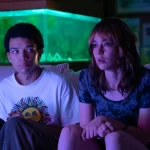Home Video Hovel: Muriel, or The Time of Return, by David Bax
The opening scene of Alain Resnais’ Muriel, or the Time of Return, depicting a discussion between a woman who runs an antique store out of her apartment and one of her customers, is filled with the strokes of avant garde flair we’ve come to associate with the director. Quick cutaways to hands and objects in the scene take up as much time as the shots of the two women doing the talking. The conversation is abstracted into fragments and eventually the dialogue ceases to be the point, instead becoming a facet of the sequence equal to any other. For the rest of the film, though, Resnais largely avoids these stylistic embellishments. Certainly, by most cinematic standards, Muriel would rank as exceedingly unconventional, what with its leaps in time. But from the director of Hiroshima Mon Amour and Last Year at Marienbad, it counts as downright middlebrow. Perhaps it’s his switch to color that makes the film feel less conspicuously “artsy” (though he would return to anti-narrative mindfuckery five years later with the superb Je t’aime, je taime, also in color). All these thoughts occurred to me while watching Criterion’s new Blu-ray release but, in the end, it’s another fiercely political yet powerfully empathetic work of art from Resnais.
Hélène (Delphine Seyrig), the woman who owns the antique shop, lives with her stepson, Bernard (Jean-Baptiste Thierrée), a young man recently returned from military service in Algeria currently in possession of no direction and a headful of bad thoughts. The action proper kicks off when Alphonse (Jean-Pierre Kérien), a former lover of Hélène, returns to the town of Boulogne-sur-Mer in the company of a young woman named Françoise (Nita Klein), whom he calls his niece (she is not his niece). Alphonse is also just back from Algeria, where he owned a café. These overlapping pasts (Hélène and Alphonse’s relationship; war and commerce in Algeria) will thread through the movie’s narrative.
As in Hiroshima and Marienbad, Muriel is largely focused on people with very strong feelings for one another who spend far more time talking about those feelings than doing anything about them. That’s not a complaint, though. Resnais uses sound, varying distances of camera placement and an up-tempo editing cadences (not to mention the great actors and screenplay) to make dialogue scenes the most riveting parts of his movie.
Bernard doesn’t have a love interest to bat dialogue back and forth with but, just like Hélène and Alphonse, he bears an unbreakable connection within his memories. When he talks, to Hélène or to Françoise or to his friends, he can’t seem to help but bring up Muriel, a girl he knew in Algeria. The eventual, devastating revelations about who precisely Muriel is and what she means to Bernard constitute the film’s emotional core as well as its political one while also best illustrating Muriel’s theme about the past’s hold on the present. In one scene, a character exclaims with anguish, “Can’t we be done with the past?” Thankfully for us, Resnais’ characters never can.
Muriel’s transfer is a new, 4K one that looks great and sharp, while preserving the visual aesthetic of the early to mid-1960s. The sound is also very well mixed, as is necessary with Resnais.
Special features include an excerpt from a 1980 documentary on Resnais, an excerpt from a 1969 interview with Seyrig, an interview with the score’s composer, Hans Werner Henze, an interview with François Thomas, author of a book on Resnais and an essay by film scholar James Quandt.





























